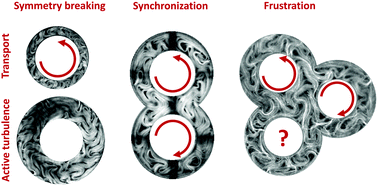Active microfluidic transport in two-dimensional handlebodies†
Abstract
Unlike traditional nematic liquid crystals, which adopt ordered equilibrium configurations compatible with the topological constraints imposed by the boundaries, active nematics are intrinsically disordered because of their self-sustained internal flows. Controlling the flow patterns of active nematics remains a limiting step towards their use as functional materials. Here we show that confining a tubulin–kinesin active nematic to a network of connected annular microfluidic channels enables controlled directional flows and autonomous transport. In single annular channels, for narrow widths, the typically chaotic streams transform into well-defined circulating flows, whose direction or handedness can be controlled by introducing asymmetric corrugations on the channel walls. The dynamics is altered when two or three annular channels are interconnected. These more complex topologies lead to scenarios of synchronization, anti-correlation, and frustration of the active flows, and to the stabilisation of high topological singularities in both the flow field and the orientational field of the material. Controlling textures and flows in these microfluidic platforms opens unexplored perspectives towards their application in biotechnology and materials science.



 Please wait while we load your content...
Please wait while we load your content...